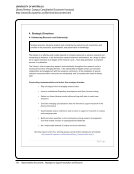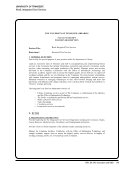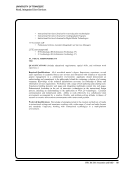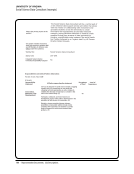54 · Survey Results: Survey Questions and Responses
30. Has your library assessed or evaluated the utility of R&D activities overall? N=29
Yes 4 14%
Not yet, but we plan to 8 28%
No, and we have no plans to 17 59%
31. If yes or you plan to, please briefly describe the assessment process. N=7
Ad-hoc review by steering committee (AUL’s +UL)
Assessment is done within Applied Research and evaluated by agency senior leaders.
In 2011–12, the library analyzed 10 years of sponsored research projects, and carried out interviews with library faculty
and academic professionals who were investigators on these projects, to determine how to strengthen support for R&D
activities in the library. The results of this survey and analysis were written as a paper by Jamie McGowan and Beth
Sandore Namachchivaya for the ARL Assessment conference in October 2012. The paper is available at: http://hdl.
handle.net/2142/35316
This is quite informal. Because useful improvements that address user needs have come from the UX studies, we have
not created a separate assessment.
This would be a long-term identification of R&D initiatives and their long-term success based on outcomes analysis.
We want to formalize assessment of various pilots in a more consistent process. This work will likely emerge as an
outcome of the library strategic directions, in which enhancing assessment is strong.
Will be part of a new overall assessment project.
32. Please briefly describe how the library determines that a project should move from an experiment
to a production service or product. N=27
1) Management review
2) Senior management review depending on size and nature of project
A formal proposal is made to the dean of libraries including background and rationale for establishing services, detailed
service scope, operational plan, and budget.
Adoption can be based on data, on user feedback, or through a formal or informal adoption process. Adoption is not
always formal, depending on scale. We do few projects that are high-risk and focus more on outcomes that may have
various solutions that are tested and revised over time.
Assessments as indicated above, survey of similar activities/services at peer institutions, staff evaluation
At the Libraries, a variety of projects are initiated on an experimental, exploratory basis. After those trial or pilot
programs have had the opportunity to develop, they are assessed to determine whether they should continue, continue
in modified form, or cease. Because no two projects are alike, there is no predetermined format for assessment, but
in nearly all cases, judgments are made on the basis of factors such as informal feedback from users, reports from
library staff members about more and less successful instances of program activity, focus groups or user experience
observation (if appropriate), and analysis of statistical information (if relevant and available). Funding needs and
potential sources of funding also are taken into account. Finally, a range of promising ideas is evaluated by library
30. Has your library assessed or evaluated the utility of R&D activities overall? N=29
Yes 4 14%
Not yet, but we plan to 8 28%
No, and we have no plans to 17 59%
31. If yes or you plan to, please briefly describe the assessment process. N=7
Ad-hoc review by steering committee (AUL’s +UL)
Assessment is done within Applied Research and evaluated by agency senior leaders.
In 2011–12, the library analyzed 10 years of sponsored research projects, and carried out interviews with library faculty
and academic professionals who were investigators on these projects, to determine how to strengthen support for R&D
activities in the library. The results of this survey and analysis were written as a paper by Jamie McGowan and Beth
Sandore Namachchivaya for the ARL Assessment conference in October 2012. The paper is available at: http://hdl.
handle.net/2142/35316
This is quite informal. Because useful improvements that address user needs have come from the UX studies, we have
not created a separate assessment.
This would be a long-term identification of R&D initiatives and their long-term success based on outcomes analysis.
We want to formalize assessment of various pilots in a more consistent process. This work will likely emerge as an
outcome of the library strategic directions, in which enhancing assessment is strong.
Will be part of a new overall assessment project.
32. Please briefly describe how the library determines that a project should move from an experiment
to a production service or product. N=27
1) Management review
2) Senior management review depending on size and nature of project
A formal proposal is made to the dean of libraries including background and rationale for establishing services, detailed
service scope, operational plan, and budget.
Adoption can be based on data, on user feedback, or through a formal or informal adoption process. Adoption is not
always formal, depending on scale. We do few projects that are high-risk and focus more on outcomes that may have
various solutions that are tested and revised over time.
Assessments as indicated above, survey of similar activities/services at peer institutions, staff evaluation
At the Libraries, a variety of projects are initiated on an experimental, exploratory basis. After those trial or pilot
programs have had the opportunity to develop, they are assessed to determine whether they should continue, continue
in modified form, or cease. Because no two projects are alike, there is no predetermined format for assessment, but
in nearly all cases, judgments are made on the basis of factors such as informal feedback from users, reports from
library staff members about more and less successful instances of program activity, focus groups or user experience
observation (if appropriate), and analysis of statistical information (if relevant and available). Funding needs and
potential sources of funding also are taken into account. Finally, a range of promising ideas is evaluated by library
































































































































































































